E/E Architecture Research: How will the zonal EEA evolve and materialize from the perspective of supply chain deployment?
Through the lens of development trends, automotive EEA (Electronic/electrical Architecture) will eventually evolve to central computing architectures with functional logics centralized in one central controller. OEMs become ever more radical in EEA planning. For OEMs, the year of 2023- 2023 will be a key time node to mass-produce the next-generation “quasi-central computing + zone” architecture.
Evolution Trends of Automotive E/E Architecture in the Next 5- 10 Years
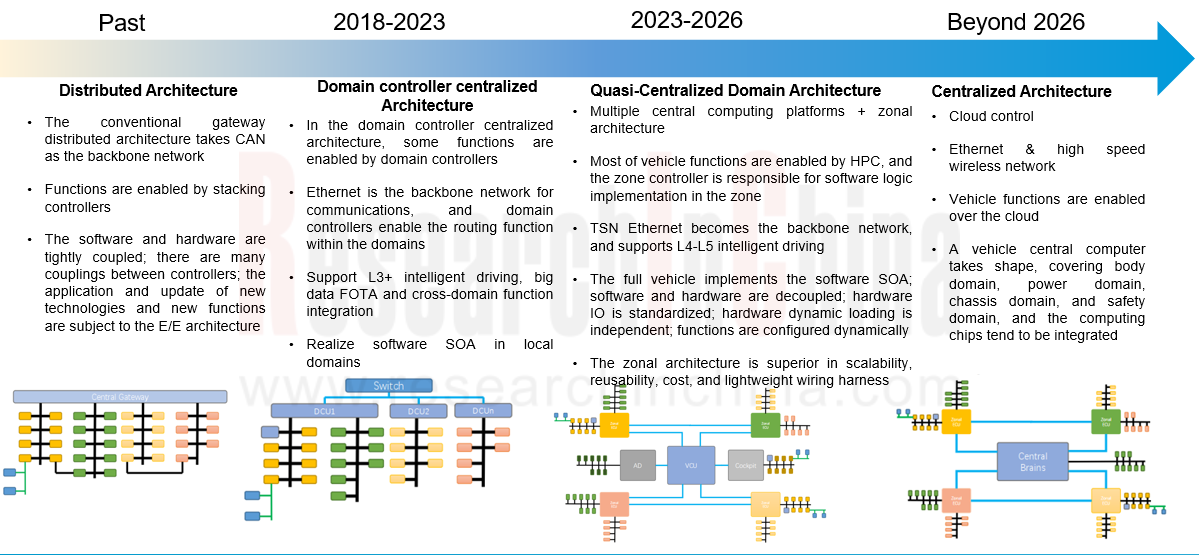
Source: ResearchInChina
The “quasi-central computing + zone” architecture can be further subdivided into many types:
 Body-zonal architecture: The controller of the body zone is connected to the central computing unit through the high-speed Ethernet backbone network, and the central computing unit integrates the functions like vehicle control, body control and gateways, simplifying the network topology, wiring harness layout and weight;
Body-zonal architecture: The controller of the body zone is connected to the central computing unit through the high-speed Ethernet backbone network, and the central computing unit integrates the functions like vehicle control, body control and gateways, simplifying the network topology, wiring harness layout and weight;
 X-domain zonal architecture: The functional zone is combined with the body zone, and the X-domain uses a more powerful processor unit, which can independently call the sensors in the zone and process data;
X-domain zonal architecture: The functional zone is combined with the body zone, and the X-domain uses a more powerful processor unit, which can independently call the sensors in the zone and process data;
 Software-defined vehicle (SDV) optimized architecture: With centralized and service-oriented computing, the central computer of vehicle has powerful processing capability and makes all decisions, while zonal controllers supply power and perform the instructions issued by the central control unit.
Software-defined vehicle (SDV) optimized architecture: With centralized and service-oriented computing, the central computer of vehicle has powerful processing capability and makes all decisions, while zonal controllers supply power and perform the instructions issued by the central control unit.
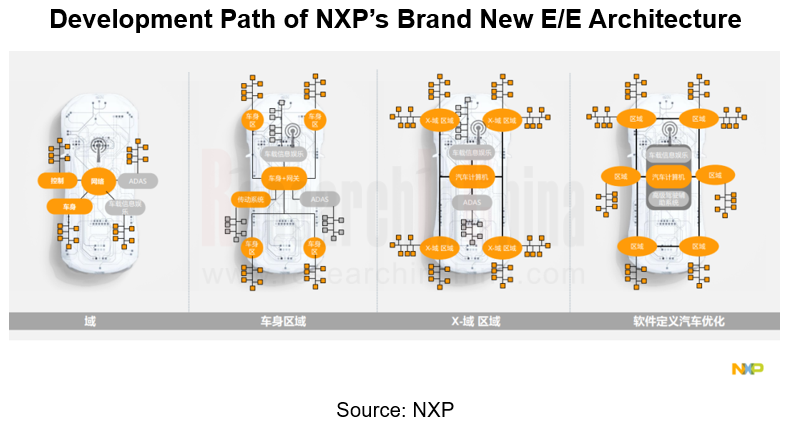
Under zonal architecture, MCUs tend to feature high performance and multi-core
In the future central integrated E/E architecture, the central processing unit communicates with zonal controllers through Ethernet, while zonal controllers communicate with sub-ECUs, sensors and actuators through CAN/LIN bus.
Physically, the zonal controllers logically concentrate multiple ECUs, proposing a higher requirement for the computing power of MCU in the zonal controllers. In the traditional ECUs with simple functions, a single-core MCUs with low performance are qualified, while zonal controllers often require multi-core MCUs. In a multi-core MCU, each core can run a single function, while multi-core can realize multiple functions, thus realizing the integration of multiple ECU functions.
 X-Soul Architecture of GAC Aion GA3.0
X-Soul Architecture of GAC Aion GA3.0
The newly-launched Hyper GT is the world's first model that uses NXP S32G3 as the central computing unit processor. The "central computing unit" developed by Continental adopts the latest "NXP S32G399 high-performance gateway computing chip". The basic middle layer of the software architecture of the front and rear zonal controllers adopts atomic service packaging and standardized interfaces, and the middle layer uses enhanced composite services and can be implemented independently.
 Xpeng’s X-EEA3.0
Xpeng’s X-EEA3.0
For the first time in China, it has attained a communication architecture with Gigabit Ethernet as the backbone and supports multiple communication protocols, making vehicle data transmission faster. The central computing unit and zonal controllers of X-EEA3.0 adopt Renesas’ flagship MCU based on the third-generation RXv3 CPU core. On the basis of X-EEA3.0, Xpeng G6 has further mass-produced and deployed the new Fuyao X-EEA3.5.
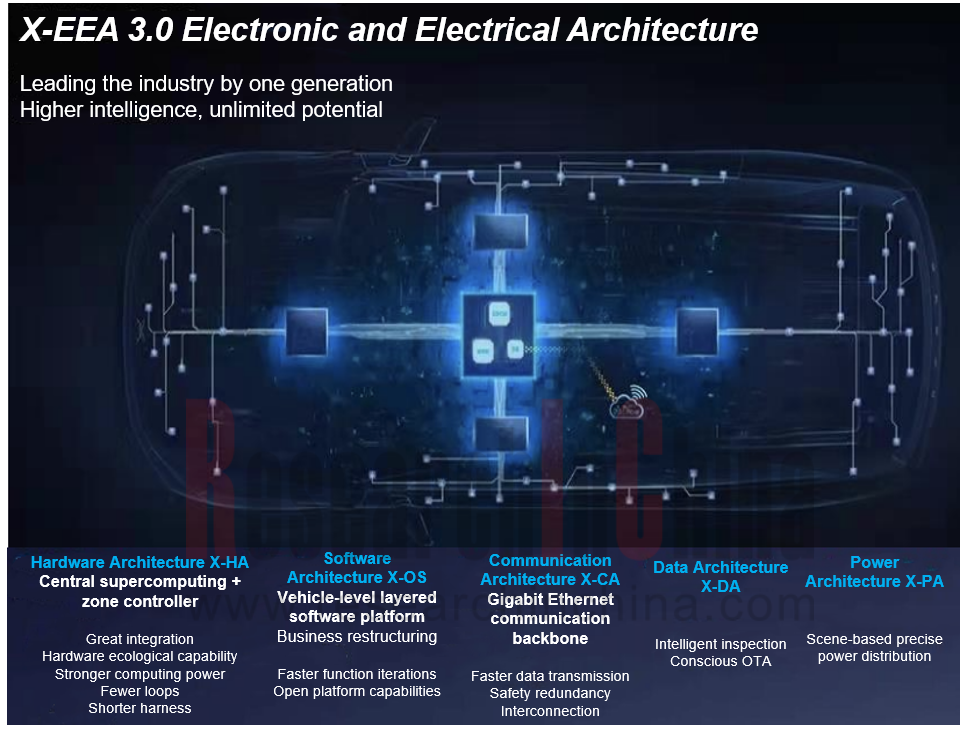
Source: Xpeng
 Infineon's 3rd-generation AURIX? TC4xx MCU
Infineon's 3rd-generation AURIX? TC4xx MCU
High-performance AURIX? TC4xx family mainly meets the new requirements of the central computing and zonal control. It is equipped with up to six TriCore? 1.8 embedded cores, each with a clock frequency of up to 500MHz; integrated with a PPU coprocessor, it can realize fast vector operation, basic neural network algorithms and other complex mathematical algorithms. In future regional controllers, PPU can be used in some information security algorithms for modeling, model predictive control, and anti-intrusion detection.
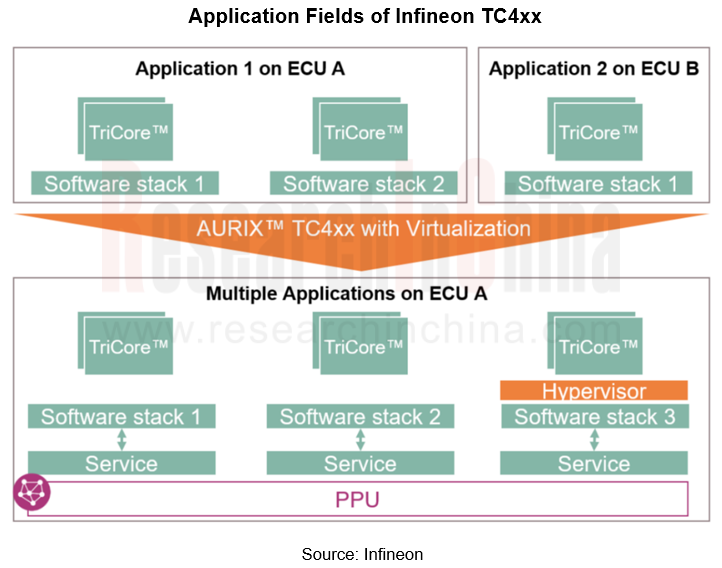
Under zonal architecture, the demand for automotive Ethernet PHY and switch chips soars, so that the price fluctuates sharply.
The interface circuit of automotive Ethernet is mainly composed of MAC controllers and PHY chips. In terms of integration method, embedded chip vendors generally integrate the MAC inside the MCU/CPU. For example, Infineon's AURIX integrates MAC into the main MCU, and also integrates CRE/DRE, the dedicated hardware communication routing module; whereas, the PHY chip is provided by the OEM or controller supplier as an independent chip.
The global Ethernet switch/PHY chip market size hit about USD800 million in 2023, and it is expected to reach USD2.5 billion in 2028. It is estimated that each car will use 2-4 Ethernet switch chips and 2-4 PHY chips on average by 2028.
Since 2023, the short-term price of some Ethernet PHY and switch chips of Broadcom BCM89 family has soared several times, with a single chip valued USD30-40. The BCM8955X family is Broadcom's third-generation automotive Ethernet switch solutions, which are mainly used in ADAS, infotainment systems and gateways. At present, Broadcom mainly promotes the BCM8957X family, which is the only automotive Ethernet switch in the world that supports the 802.3ch standard.
In a typical central computing + zonal architecture, each zonal gateway contains an Ethernet switch, and each vehicle requires at least 6-7 Ethernet switch chips. At present, Marvell, Broadcom, NXP and other automotive network communication chip vendors have proposed the next-generation network architecture.
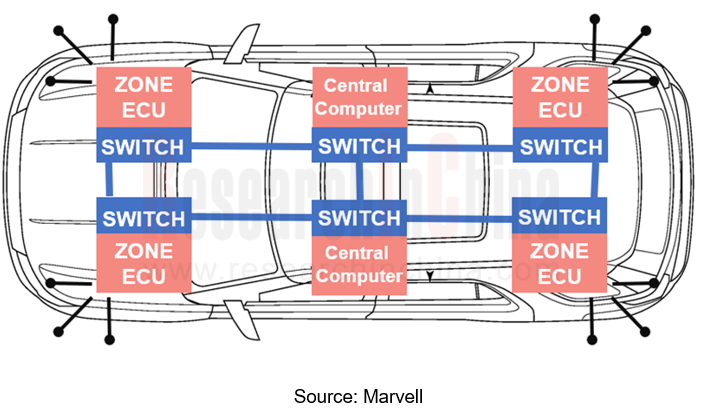
OEMs forecast that the central computing + zonal architecture will only come true in 2025 by virtue of 10G bandwidth. In June 2023, Marvell announced the Brightlane Q622x family of central Automotive Ethernet switches to support the zonal networking architectures of next-generation vehicles. Central Automotive Ethernet switches are high-bandwidth, high-performance devices optimized to coordinate data traffic between zonal switches, which aggregate traffic from devices located within a physical zone of a car like processors, sensors, actuators, storage systems and others.
In the 10 Gigabit automotive Ethernet chip market, only Marvell and Broadcom can provide 10G+ Ethernet switches.
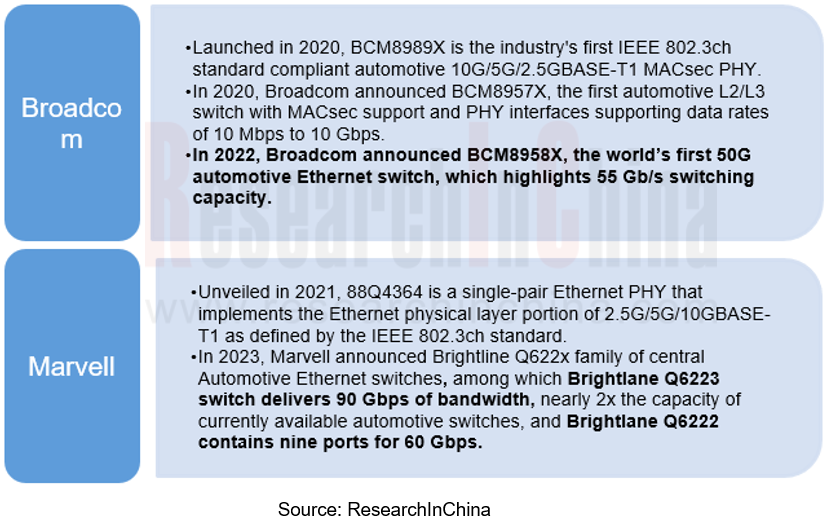
Under zonal architecture, the on-chip high-speed communication of central computer requires PCIe switches.
Driven by Chat GPT, the demand for AI servers has skyrocketed, and PCIe Switch chips represented by Broadcom SS26 are in shortage with the price swelling. In the next-generation E/E architecture, expensive PCIe switches are required by connection between multi-SoC cascade, SSD storage based on PCIe and the central SoC.
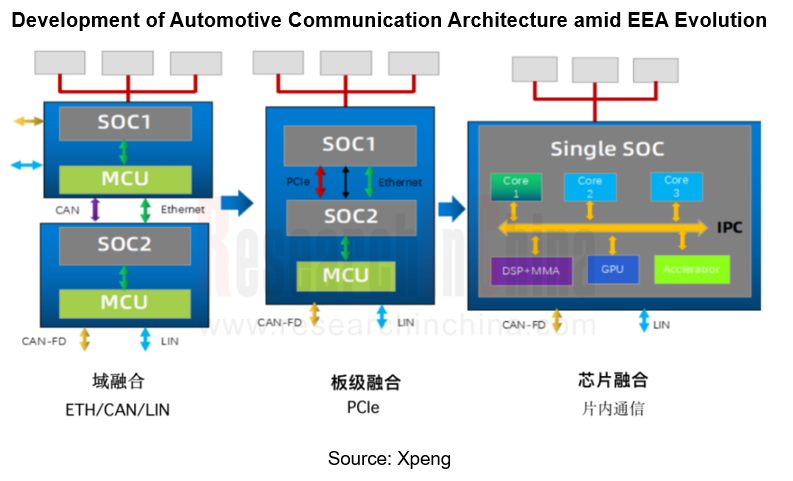
The cross-domain communication of automobiles will be based on PCIe, which can improve the communication efficiency to dozens of gigabytes compared with the previous Ethernet, and PCIe Switch enables the on-chip communication. Ethernet Switches are mounted on different SoCs in the central computing unit. The external sensors are connected in series through the Ethernet switches of zonal ECUs.
 Qualcomm's first-generation autonomous driving system, Ride3.0, uses PCIe switches in the automotive industry for the first time, that is, Microchip's PM43028B1-F3EI priced at about $100 dollars, higher than that of SA8155P and almost 4-5 times that of Ethernet switches.
Qualcomm's first-generation autonomous driving system, Ride3.0, uses PCIe switches in the automotive industry for the first time, that is, Microchip's PM43028B1-F3EI priced at about $100 dollars, higher than that of SA8155P and almost 4-5 times that of Ethernet switches.
 Visteon’s dual Qualcomm 8155 cockpit domain controllers are internally connected via the PCIe bus. Two 8155 SoCs are connected through PCle bus, with the transmission rate of 16Gbps, which can efficiently transmit the real-time video input of ADAS.
Visteon’s dual Qualcomm 8155 cockpit domain controllers are internally connected via the PCIe bus. Two 8155 SoCs are connected through PCle bus, with the transmission rate of 16Gbps, which can efficiently transmit the real-time video input of ADAS.
 SiEngine Technology has customized the high-speed interconnection bus SE-LINK for ECARX to realize the simultaneous operation of two "Longying No.1" chips. Two Antora 1000 platforms are connected to get Antora 1000 Pro. It can provide double computing power while maintaining the transmission speed, wherein the transmission speed of PCIe 3.0 Lane reaches 7.28 GT/s.
SiEngine Technology has customized the high-speed interconnection bus SE-LINK for ECARX to realize the simultaneous operation of two "Longying No.1" chips. Two Antora 1000 platforms are connected to get Antora 1000 Pro. It can provide double computing power while maintaining the transmission speed, wherein the transmission speed of PCIe 3.0 Lane reaches 7.28 GT/s.
EEA evolution drives the upheaval of underlying OS of vehicle
Adaptive AUTOSAR introduces the service-oriented architecture (SOA) and support for POSIX system, suitable for high-computing SoCs. SOA or the service-based middleware platform is also known as the automotive OS.
 The SOA of GAC's X-Soul architecture has realized standardized layered interfaces, software modularization, function atomization, remote function configuration and so on through the layered decoupled basic software architecture platform. GAC's X-Soul architecture is China's first product developed based on the ASF (AUTOSEMO Service Framework) technical specification. On the basis of the SOA, the GAC Rubik's Cube scenario co-creation platform has been mass-produced with GAC Aion Hyper GT.
The SOA of GAC's X-Soul architecture has realized standardized layered interfaces, software modularization, function atomization, remote function configuration and so on through the layered decoupled basic software architecture platform. GAC's X-Soul architecture is China's first product developed based on the ASF (AUTOSEMO Service Framework) technical specification. On the basis of the SOA, the GAC Rubik's Cube scenario co-creation platform has been mass-produced with GAC Aion Hyper GT.
 In April 2023, Huawei released the iDVP intelligent digital base, which is a SOA that allows zonal access and central computing. iDVP includes a hardware platform and a software platform. The hardware platform refers to the basic hardware platform of the computing and communication architecture, and the software platform includes an operating system, a basic management framework and a SOA software framework. In order to facilitate users to develop software on iDVP, Huawei has developed a supporting tool chain.
In April 2023, Huawei released the iDVP intelligent digital base, which is a SOA that allows zonal access and central computing. iDVP includes a hardware platform and a software platform. The hardware platform refers to the basic hardware platform of the computing and communication architecture, and the software platform includes an operating system, a basic management framework and a SOA software framework. In order to facilitate users to develop software on iDVP, Huawei has developed a supporting tool chain.
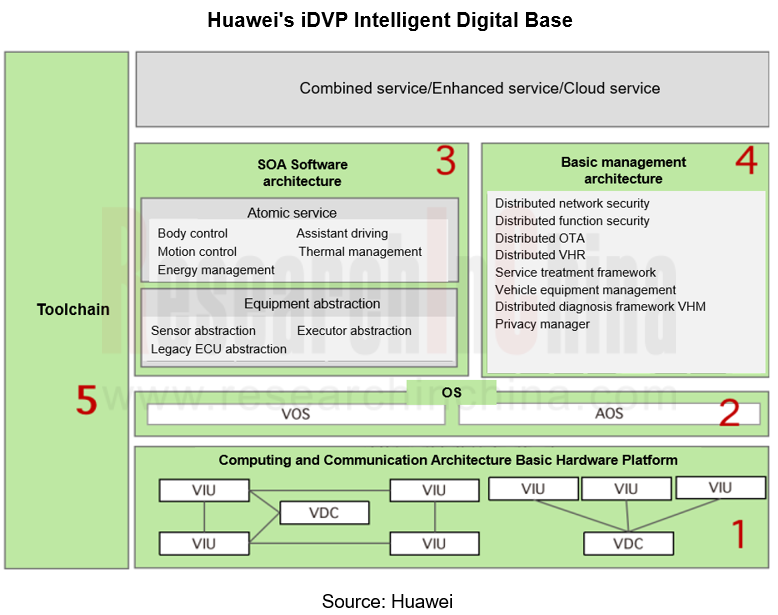
China Passenger Car Mobile Phone Wireless Charging Research Report, 2024
China Passenger Car Mobile Phone Wireless Charging Research Report, 2024 highlights the following:Passenger car wireless charging (principle, standards, and Qi2.0 protocol);Passenger car mobile phone ...
Automotive Smart Exteriors Research Report, 2024
Research on automotive smart exteriors: in the trend towards electrification and intelligence, which exteriors will be replaced by intelligence?
The Automotive Smart Exteriors Research Report, 2024 ...
Automotive Fragrance and Air Conditioning System Research Report, 2024
Research on automotive fragrance/air purification: With surging installations, automotive olfactory interaction is being linked with more scenarios.
As users require higher quality of personalized, i...
Intelligent Vehicle Multi-Domain Computing Industry Report, 2024
Multi-Domain Computing Research: A Summary of Several Ideas and Product Strategies for Cross-Domain Integration
1. Several ideas and strategies for cross-domain integration of OEMs
With the increasi...
Analysis on Xiaomi Auto's Electrification, Connectivity, Intelligence and Sharing, 2024
Research on Xiaomi Auto: Xiaomi Auto's strengths and weaknesses
Since the release of SU7, Xiaomi delivered 7,058 units and 8,630 units in April and May, respectively, and more than 10,000 units in bo...
ADAS and Autonomous Driving Tier 1 Suppliers Research Report, 2024 - Foreign Companies
Research on foreign ADAS Tier 1 suppliers: make all-round attempts to transform and localize supply chain and teams.
1. Foreign ADAS Tier 1 suppliers fall behind relatively in deve...
Research Report on Passenger Car Cockpit Entertainment--In-vehicle Game, 2024
1. In-vehicle entertainment screens are gaining momentum, and Chinese brands rule the roost.
In-vehicle entertainment screens refers to display screens used for entertainment activities such as viewi...
Body (Zone) Domain Controller and Chip Industry Research Report,2024
Research on body (zone) domain controller: an edge tool to reduce vehicle costs, and enable hardware integration + software SOA.
Integration is the most important means to lower vehicle costs. Funct...
China Charging/Swapping (Liquid Cooling Overcharging System, Small Power, Swapping, V2G, etc) Research Report, 2024
Research on charging and swapping: OEMs quicken their pace of entering liquid cooling overcharging, V2G, and virtual power plants.
China leads the world in technological innovation breakthroughs in ...
Autonomous Driving SoC Research Report, 2024
Autonomous driving SoC research: for passenger cars in the price range of RMB100,000-200,000, a range of 50-100T high-compute SoCs will be mass-produced. According to ResearchInChina’s sta...
Automotive Cockpit Domain Controller Research Report, 2024
Research on cockpit domain controller: Facing x86 AI PC, multi-domain computing, and domestic substitution, how can cockpit domain control differentiate and compete?
X86 architecture VS ARM ar...
Chinese OEMs (Passenger Car) Going Overseas Report, 2024--Germany
Keywords of Chinese OEMs going to Germany: electric vehicles, cost performance, intelligence, ecological construction, localization
The European Union's temporary tariffs on electric vehicles in Chi...
Analysis on DJI Automotive’s Autonomous Driving Business, 2024
Research on DJI Automotive: lead the NOA market by virtue of unique technology route.
In 2016, DJI Automotive’s internal technicians installed a set of stereo sensors + vision fusion positioning syst...
BYD’s Layout in Electrification, Connectivity, Intelligence and Sharing and Strategy Analysis Report, 2023-2024
Insight: BYD deploys vehicle-mounted drones, and the autonomous driving charging robot market is expected to boom.
BYD and Dongfeng M-Hero make cross-border layout of drones.
In recent years,...
Great Wall Motor’s Layout in Electrification, Connectivity, Intelligence and Sharing and Strategy Analysis Report, 2023-2024
Great Wall Motor (GWM) benchmarks IT giants and accelerates “Process and Digital Transformation”.
In 2022, Great Wall Motor (GWM) hoped to use Haval H6's huge user base to achieve new energy transfo...
Cockpit AI Agent Research Report, 2024
Cockpit AI Agent: Autonomous scenario creation becomes the first step to personalize cockpits
In AI Foundation Models’ Impacts on Vehicle Intelligent Design and Development Research Report, 2024, Res...
Leading Chinese Intelligent Cockpit Tier 1 Supplier Research Report, 2024
Cockpit Tier1 Research: Comprehensively build a cockpit product matrix centered on users' hearing, speaking, seeing, writing and feeling.
ResearchInChina released Leading Chinese Intelligent Cockpit ...
Global and China Automotive Wireless Communication Module Market Report, 2024
Communication module and 5G research: 5G module installation rate reaches new high, 5G-A promotes vehicle application acceleration
5G automotive communication market has exploded, and 5G FWA is evolv...